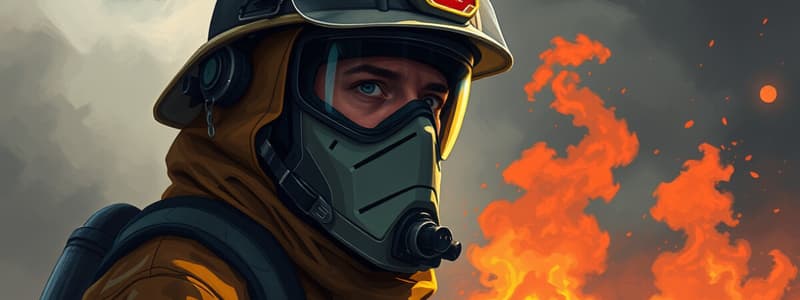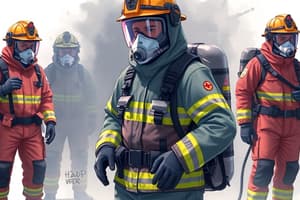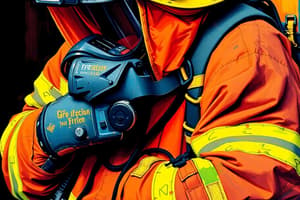Podcast
Questions and Answers
What is the primary purpose of the National Fire Protection Association (NFPA) 1851 guidelines?
What is the primary purpose of the National Fire Protection Association (NFPA) 1851 guidelines?
- To promote the creation of new firefighting techniques
- To provide training standards for fire rescue personnel
- To establish maintenance requirements for firefighting vehicles
- To reduce health and safety risks from improper management of firefighting PPE (correct)
Under what conditions is a firefighting hood considered contaminated?
Under what conditions is a firefighting hood considered contaminated?
- If it has visible soot but no contact with fire
- If it has been exposed to heat but without direct contact with hazardous materials
- When it has come in contact with blood or any hazardous substances (correct)
- If it has been worn for more than one shift
What specific actions must personnel take regarding hoods after they have been used?
What specific actions must personnel take regarding hoods after they have been used?
- Clean the hood immediately after use (correct)
- Conduct a routine inspection at the end of the shift
- Allow the hood to air out before storage
- Exchange the hood for a new one if it appears dirty
What is NOT a requirement for personnel regarding their firefighting hoods?
What is NOT a requirement for personnel regarding their firefighting hoods?
How often should the routine inspection of firefighting hoods be conducted?
How often should the routine inspection of firefighting hoods be conducted?
Which of the following is a responsibility of all employees regarding firefighting hoods?
Which of the following is a responsibility of all employees regarding firefighting hoods?
What is the recommended storage condition for firefighting hoods?
What is the recommended storage condition for firefighting hoods?
What is a common misconception regarding soot and products of combustion in relation to firefighting PPE?
What is a common misconception regarding soot and products of combustion in relation to firefighting PPE?
Which action should be taken if a firefighting hood shows signs of physical damage?
Which action should be taken if a firefighting hood shows signs of physical damage?
What is the minimum frequency for advanced inspection and cleaning of firefighting hoods by the Independent Service Provider?
What is the minimum frequency for advanced inspection and cleaning of firefighting hoods by the Independent Service Provider?
When wearing a firefighting hood, what should it cover regarding the SCBA mask?
When wearing a firefighting hood, what should it cover regarding the SCBA mask?
What is the proper protocol for removing a contaminated hood?
What is the proper protocol for removing a contaminated hood?
What is required when a firefighting hood becomes contaminated?
What is required when a firefighting hood becomes contaminated?
During a hood exchange, what must the contaminated hoods be secured in?
During a hood exchange, what must the contaminated hoods be secured in?
Who is responsible for maintaining the inventory and condition of firefighting hoods?
Who is responsible for maintaining the inventory and condition of firefighting hoods?
What must the Air Truck personnel do with contaminated hoods?
What must the Air Truck personnel do with contaminated hoods?
If the supplies in the Battalion Chief Hood Swap Bag need replacement, who must order them?
If the supplies in the Battalion Chief Hood Swap Bag need replacement, who must order them?
What should be done immediately after removing a contaminated hood in an IDLH environment?
What should be done immediately after removing a contaminated hood in an IDLH environment?
Which item is NOT included in the Battalion Chief Hood Swap Bag?
Which item is NOT included in the Battalion Chief Hood Swap Bag?
What procedure must be followed if a hood is contaminated while at an incident?
What procedure must be followed if a hood is contaminated while at an incident?
How is the condition of the contaminated hoods documented?
How is the condition of the contaminated hoods documented?
When should a firefighter not wear a contaminated hood around their neck?
When should a firefighter not wear a contaminated hood around their neck?
Flashcards are hidden until you start studying
Study Notes
Firefighting PPE Standards and Responsibilities
- Miami-Dade Fire Rescue follows NFPA 1851 guidelines for firefighting protective equipment maintenance.
- Proper maintenance of firefighting hoods is crucial to mitigate health risks from toxic chemicals and hazardous substances.
- Decontamination wipes are issued for personnel to clean skin of toxins and fire byproducts.
Firefighting Hood Maintenance and Care
- All employees must maintain clean firefighting hoods, which are to be worn, inspected, and exchanged routinely.
- Contaminated hoods are defined as those that have been in contact with hazardous materials, including soot and chemicals.
- Hoods should not be personalized or altered, stored in a clean, dry place away from sunlight, and the label must remain intact.
Hood Inspection Protocols
- Routine inspections of firefighting hoods should be performed at the start of each shift, after use, and upon issuance of a new hood.
- Inspections focus on soiling, contamination, physical damage, and label legibility.
- Any issues found during inspections must be reported to a supervisor immediately.
Wearing and Removing the Hood
- Hoods should cover the edge of the SCBA mask without obstructing vision and should always be tucked into the bunker gear coat.
- Reminders to never wear a contaminated hood around the neck and to remove it safely while still wearing gloves to prevent additional contamination.
Hood Exchange Procedures
- Employees must exchange contaminated hoods for clean ones after use at incident scenes.
- Battalion Chiefs carry a special bag containing clean hoods, decontamination wipes, and supplies for handling contaminated hoods.
- Contaminated hoods are secured and labeled before being transported to Air Depot Stations for exchange.
Logistics of Hood Maintenance
- The Inventory and Supply Bureau (ISB) oversees cleaning, storage, and supply for firefighting hoods and ensures adequate inventories for the exchange process.
- Daily inventory checks will be conducted on Hood Swap Bags to ensure all necessary supplies are available for exchanges.
- Air Truck personnel are responsible for exchanging contaminated hoods and maintaining the supply chain cycle effectively.
Studying That Suits You
Use AI to generate personalized quizzes and flashcards to suit your learning preferences.



